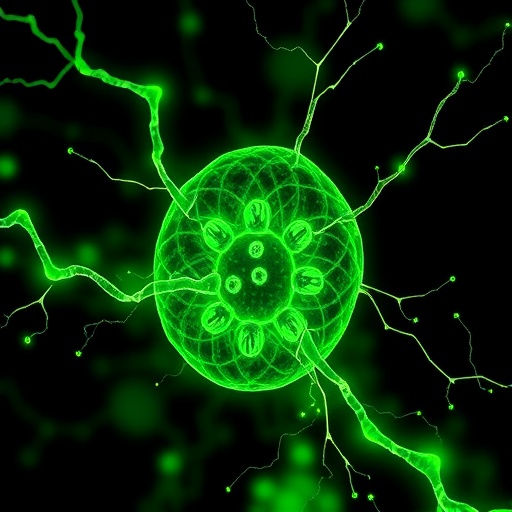Recent advances in biomedical research have illuminated the intricate relationship between electrical stimulation and cellular processes. The pioneering work by Malakauskaitė and colleagues sheds light on a remarkably innovative area: the impact of ultra-fast nanosecond electric pulses on mitochondrial function. By exploring this nexus, the researchers are not merely uncovering new facets of bioelectricity; they are laying the groundwork for potentially transformative therapeutic strategies.
At the core of this study is the mitochondrion, often characterized as the powerhouse of the cell. Its multifunctional role extends beyond energy production; it is integral to regulating cellular respiration, apoptosis, and metabolic homeostasis. Researchers have long sought to augment mitochondrial function, particularly in the context of various diseases characterized by mitochondrial dysfunction. Malakauskaitė et al. have propelled this inquiry forward by investigating how precisely timed electric pulses can modulate mitochondrial properties.
The focus on ultra-fast nanosecond electric pulses is particularly noteworthy. Traditional electroporation techniques involve longer pulses that cause extensive disruptions to cellular membranes. In contrast, nanosecond pulses are remarkable for their ability to induce transient permeability changes without causing permanent damage to the cellular architecture. This unique feature underlines the potential for therapeutic applications where controlled electric fields can make subtle yet profound alterations to cellular behavior.
In this study, the researchers meticulously measured the transmembrane potential of mitochondria after exposing cells to nanosecond electric pulses. This parameter is critical as it reflects the driving force for ATP synthesis, which is imperative for cellular energy. The findings suggest that the application of these pulses resulted in a significant increase in mitochondrial membrane potential, enhancing ATP production in a variety of cell types. The implications of this enhancement could be vast, especially in regenerative medicine and in treatments targeting metabolic disorders.
To further elucidate the underlying mechanisms of these effects, the researchers examined the oxidative state of cells post-treatment. Understanding the balance between oxidative stress and antioxidant defenses is vital in elucidating how cells respond to electrical stimuli. The results of the study indicated an intricate interplay between electric pulse application and the modulation of reactive oxygen species (ROS) production. This relationship is crucial, as ROS are not merely byproducts of metabolism; they serve as signaling molecules that can initiate cellular responses leading to survival or death.
Additionally, the research delves into the potential implications for cancer therapy. Tumor cells often exploit dysfunctional mitochondrial pathways, leading to altered energy metabolism that supports rapid proliferation. By harnessing the effects of nanosecond electric pulses, there may be a novel approach to reprogram these dysfunctional metabolic pathways, ultimately enhancing the efficacy of existing treatment modalities or paving the way for new interventions.
The concept of using electric fields to influence cellular properties is not entirely new, but the precision and rapidity of the pulses explored in this study present an exciting frontier. The researchers highlight the novelty of their methodologies, which allow for acute experiments that minimize cellular adaptation or long-term changes that could skew results. This precision positions nanosecond pulse technology as an invaluable tool in understanding cellular responses to bioelectricity.
Furthermore, the researchers addressed potential applications beyond cancer therapy. For instance, the ability to modulate mitochondrial function may also extend to neurodegenerative diseases where cell death and energy depletion are prominent features. By optimizing electric pulse parameters, the potential exists to stimulate mitochondrial repair mechanisms or induce protective responses in vulnerable cell types.
The significance of these findings cannot be overstated. By showcasing that the application of ultra-fast electric pulses can improve mitochondrial function, the study paves the way for multidisciplinary collaborations. Researchers from fields such as materials science, bioengineering, and clinical medicine may converge to explore and manipulate these findings, leading to innovative therapeutic strategies that could address an array of diseases at the cellular level.
Ethically, the study addresses important considerations regarding the translation of laboratory findings into clinical settings. The potential for electric field applications in human treatments raises questions about safety, efficacy, and patient consent. The authors propose that thorough preclinical studies and a strong regulatory framework will be essential for the responsible integration of such methodologies into healthcare settings.
In conclusion, the exploration conducted by Malakauskaitė et al. serves as a significant milestone in the realm of cellular bioelectricity. The implications of their work resonate not only within the confines of specialized research but also in broader medical and therapeutic contexts. This groundbreaking research illuminates pathways to harness electric pulses for advanced biomedical applications, offering hope for innovative treatments for various diseases marked by cellular dysfunction.
The energy revolution on a cellular level identified by this research raises a plethora of questions and invites further investigation into the myriad ways bioelectric phenomena can be harnessed. As the field progresses, one can anticipate the emergence of even more unconventional and effective strategies that combine biological understanding with technological innovation.
By continuing to develop and optimize these nanosecond electric pulses, researchers may unlock novel avenues for cell therapy, organ regeneration, and other transformative healthcare solutions that could change the landscape of medicine as we know it.
Through this research, we stand on the brink of a new era where the language of biology may be spoken in terms of electric frequencies, opening doors to therapeutic interventions previously relegated to the realm of science fiction.
Subject of Research: Effects of ultra-fast nanosecond electric pulses on mitochondrial transmembrane potential and oxidation.
Article Title: Effects of ultra-fast nanosecond electric pulses on mitochondria transmembrane potential and oxidation.
Article References: Malakauskaitė, P., Želvys, A., Mickevičiūtė, E. et al. Effects of ultra-fast nanosecond electric pulses on mitochondria transmembrane potential and oxidation.
Sci Rep 15, 39778 (2025). https://doi.org/10.1038/s41598-025-23453-6
Image Credits: AI Generated
DOI: https://doi.org/10.1038/s41598-025-23453-6
Keywords: Ultra-fast electric pulses, mitochondria, transmembrane potential, oxidative stress, energy metabolism, nanosecond pulses.




